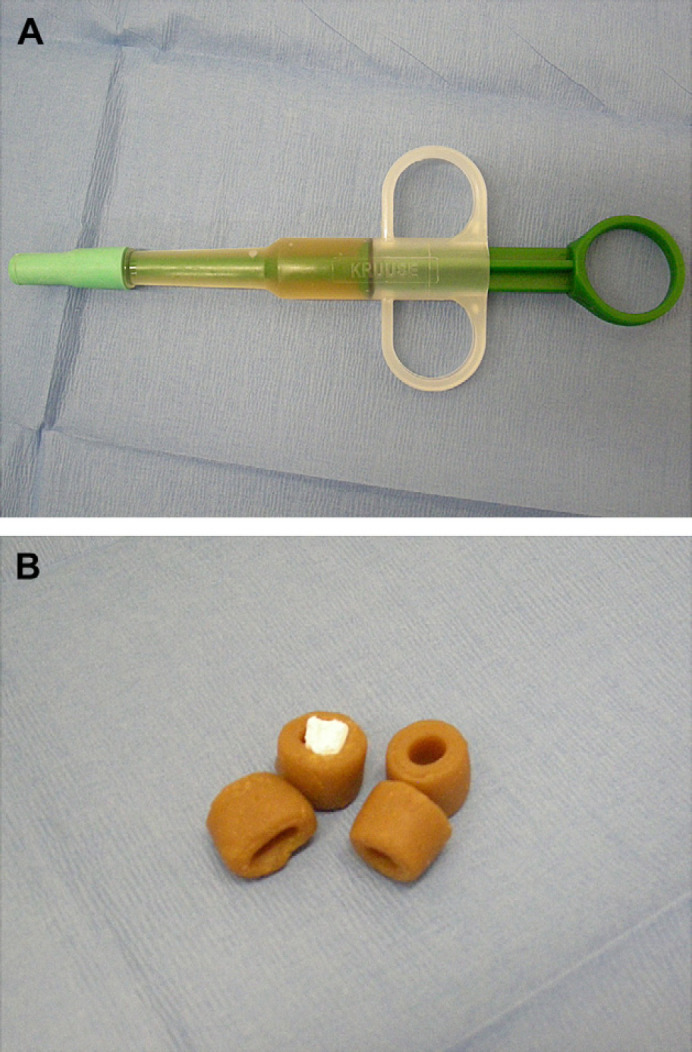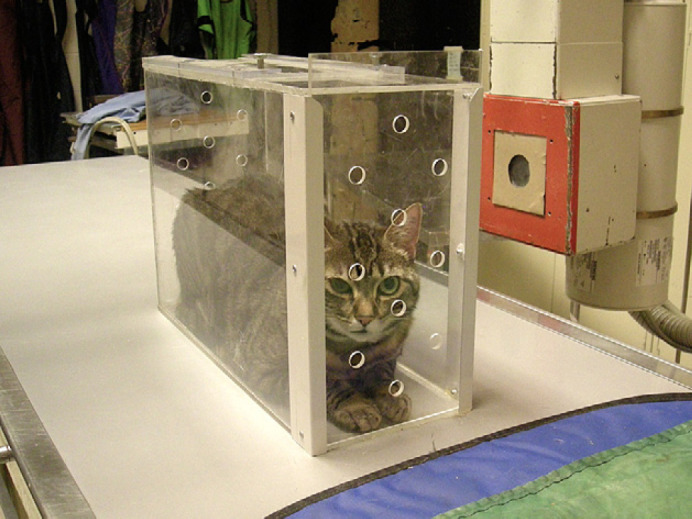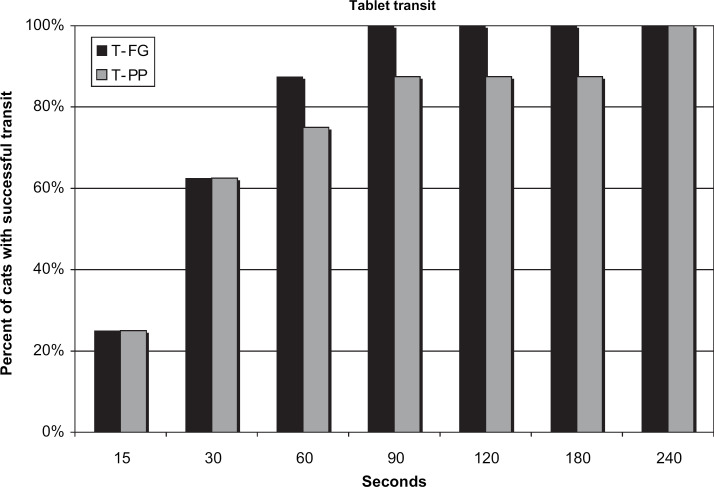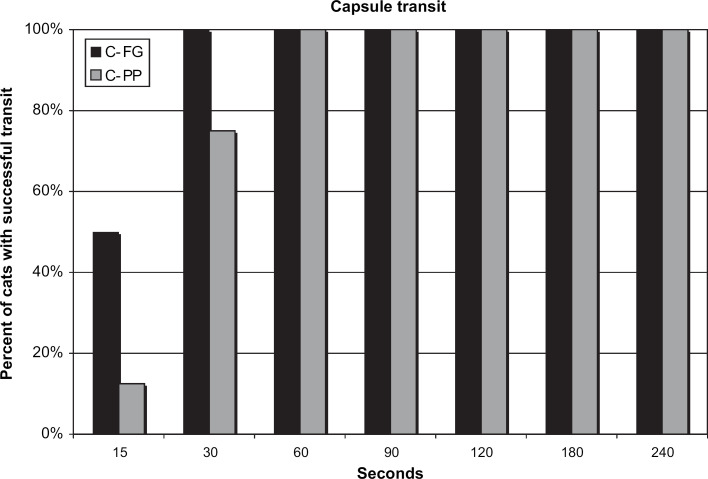Abstract
Retention of tablets or capsules in the feline esophagus can be associated with esophagitis and esophageal stricture formation. The objective of this study was to evaluate the esophageal passage of tablets and capsules when administered with either a one-step pill gun with flavored liquid (FlavoRx pill glide) or a pill delivery treat (Pill Pockets). Four different medication administrations were evaluated on different days in eight normal cats: tablets with FlavoRx pill glide (T-FG), tablets with pill delivery treats (T-PP), capsules with FlavoRx pill glide (C-FG) and capsules with pill delivery treats (C-PP). The estimated average transit time was 36 s for T-FG, 60 s for T-PP, 16 s for C-FG, and 24 s for C-PP. The results of this study suggest that either pill delivery method is acceptable for successful passage of tablets or capsules into the stomach of cats using a single replicate.
Administration of oral medications is a necessary component of feline practice. Often tablets and capsules are simply forced to the back of the cat's oral cavity with the hope that it is swallowed without the veterinarian, veterinary technician, or owner being bitten or scratched. In this scenario there is increased risk of exposure to infectious agents, such as Bartonella henselae, the primary cause of cat scratch disease in people. 1 The stress induced upon the cat is only heightened when multiple attempts are needed, further increasing the occurrence of bite wounds and exposure to pathogens. Furthermore, dry pilling cats can lead to esophageal retention of the medications. 2–4 For example, administration of tablets or capsules to cats without water has resulted in esophageal retention for 11 min in up to 50% of cats. 4 This can cause discomfort which makes the cat less receptive on future attempts to administer medications. In addition, if retention of irritating medications is prolonged, esophagitis with or without stricture formation can result. This has been identified with commonly used antibiotics, such as doxycycline and clindamycin in cats. 5,6
Numerous strategies have been used in an attempt to identify a reliable delivery system for feline medications. Use of a device to deliver the tablet or capsule to the caudal pharynx (‘pill gun’) can lessen the risk of exposure to infectious agents as this avoids placement of fingers into the cat's mouth, but does not address the issue of esophageal retention. Administration of water after delivering the tablet or capsule has been effective in shortening the transit time to the stomach, but requires additional handling of the cat. 2 Coating the tablet or capsule with butter or other viscous material like a dietary supplement (Nutrical, Vetquinol Pharmaceuticals, Buena, New Jersey) has also been shown to lessen the risk of esophageal retention. 4 Pill delivery treats are available that cover the tablet or capsule, mask the taste of the medication, and promote ingestion by the cat (Greenies Pill Pockets, S&M NuTec, Kansas City, Missouri; Fig. 1B). To our knowledge, it has not been demonstrated that medication administration in pill delivery treats results in normal esophageal transit. Many drugs supplied as tablets or capsules can be liquefied. However, this requires additional time and expense, and stability has not been determined for all drugs. Transdermal application of drugs is another potential method for medication delivery. This modality has been studied to a limited degree in cats and it was found that the bioavailability of drugs mixed with pleuronic lecithin organogel for transdermal administration can be highly variable between cats. 7,8 Thus, improved oral drug delivery systems are still needed.
Fig 1.

Medication delivery methods evaluated in this study. (A): FlavoRx pill glide (FlavoRx, Columbia, MD); (B): Greenies Pill Pockets (S&M NuTec, Kansas City, MO).
The FlavoRx pill glide (FlavoRx, Columbia, Maryland; Fig. 1A) is a device designed to deliver a bolus of flavored liquid following tablet or capsule release into the animal's mouth in one step. This is proposed to facilitate tablet or capsule delivery to the stomach, which may prevent esophagitis and stricture formation. The purpose of this study was to determine the esophageal transit time for barium tablets and capsules when administered by use of this device and within pill delivery treats.
Materials and methods
Cats
Eight clinically normal, mixed sex, neutered, young adult (approximately 1 year) research cats were enrolled in this study. The cats were determined to be healthy on physical examination and had normal values on serum biochemistry profile, and complete blood cell count. This study was approved by the Animal Care and Use Committee of Colorado State University and the cats were adopted into private homes or entered into other studies at the end of this project.
Acclimation period
Two weeks prior to initiating the study, time was spent to acclimatize the cats to a specially designed Plexiglas box. This box is 41×15.5×28 cm and was large enough to allow the cats to change position within the box. Each cat spent 5 min in the Plexiglas box every other day and was free fed Greenies Pill Pockets while within the box. This made their time in the box a positive experience and they became accustomed to the treats at the same time. On the alternate days, each cat was allowed to taste the fluid used with the FlavoRx pill glide system. We inferred that the fluid was palatable based on the positive response from the cats. The cats were not pilled or forcibly made to taste either delivery method during this time.
Tablets and capsules
Inert barium sulfate tablets (E-Z Disk, E-Z-EM, Lake Success, New York), 0.5 inches in diameter, were cut and shaped into 4 mm×2 mm tablets. This tablet size approximates the typical size of many medications used in cats, including standard dosage of doxycycline (¼ of 100 mg tablet) and a 50 mg amoxicillin tablet. Barium sulfate was also used to fill #4 gel capsules. These sizes of tablets and capsules were also used in a previous studies evaluating feline esophageal transit times. 2,3
Test periods
Barium tablet and capsule transit was determined by fluoroscopy. On the first day of the study, each cat was placed into the Plexiglas box and a tablet in a Greenies Pill Pockets (group T-PP) was then fed to the cat. Fluoroscopy was started immediately and was used to evaluate tablet passage through the esophagus continuously from 0 to 30 s, and then at the 60, 90, 120, 180, 240, 300, and 360 s after administration. Exact transit time was recorded if it was less than 30 s. Otherwise, transit time was estimated to be the individual time point when the tablet or capsule was found to be in the stomach. Fluoroscopic evaluation was discontinued as soon as the tablet was visualized within the stomach. Any cat with a retained tablet at 360 s was to be administered a 10 ml bolus of water to facilitate transit of the tablet into the stomach. The same protocol was repeated the next day using barium sulfate tablets administered with the FlavoRx pill glide (group T-FG). The study was repeated the following week with an identical protocol using the #4 gel capsules instead of tablets. On the first day, the cats were fed the capsules in Greenies Pill Pockets (group C-PP) and on next day the capsules were administered using the FlavoRx pill glide (group C-FG).
Statistical evaluation
The number of tablets and capsules successfully passing at each time interval was expressed as the proportion of successful passages per total number of attempts per time interval and presented descriptively. Average transit times between methods for pills or capsules were compared by Wilcoxon signed rank test with significance defined as P<0.05.
Results
Medication administration
All cats tolerated the box to an acceptable degree with minimal to no undue stress (Fig. 2). However, all but one cat (capsule) refused to voluntarily ingest the Greenies Pill Pockets while in the Plexiglas box in the fluoroscopy room. Thus, the medication was placed into the caudal pharynx to begin the fluoroscopy. Administration of pills and C-FG was readily accepted by all but two cats (group C-FG). In these two cats, the medication was accepted on the second administration performed several minutes later.
Fig 2.

Image of a cat within the specially designed Plexiglas box.
Esophageal transit times
Tablets and capsules passed into the stomach in all cats with both delivery methods in less than 300 s (Figs 3 and 4). The percentage of successful passages into the stomach at 30 s was 62.5% for T-FG, 62.5% for T-PP, 100% for C-FG and 75% for C-PP. The percentage of successful passage at 60 s was 87.5% for T-FG, 75% for T-PP, 100% for C-FG, and 100% for C-PP. The percentage of successful passage at 90 s was 87.5% for T-PP, and 100% for all other groups. The average transit time based on the method of measurement previously described was 36 s for T-FG (range 15–60 s), 60 s for T-PP (range 16–240 s), 16 s for C-FG (range 7–30 s), and 24 s for C-PP (range 14–60 s). There were no statistical differences between groups.
Fig 3.
Percentage of cats with the tablet in the stomach at the designated time. T/FG=tablet administered with the pill glide device; T/PP=tablet in Pill Pocket.
Fig 4.
Percentage of cats with the capsule in the stomach at the designated time. C/FG=capsule administered with the pill glide device; C/PP=capsule in Pill Pocket.
Transient retention of tablet passage (transit time >30 s) occurred in three T-PP cats and in four T-FG cats. Retention most commonly occurred at the level of the thoracic inlet (three cats), followed by the heart base (two cats). Retention occurred in the remaining cats at the level of the cervical esophagus and the proximal thoracic esophagus. Transient retention only occurred in one C-PP cat at the level of the thoracic inlet (between 30 and 60 s). No C-FG cats had transient retention.
Discussion
This study demonstrates that FlavoRx pill glide and Greenies Pill Pockets are effective methods for potentiating successful transit of tablets and capsules into the stomach of feline patients. A sufficient bolus size is needed to stimulate the proximal esophagus during physiologic swallowing to initiate primary and secondary peristalsis. It is believed that the swallowing of a tablet or capsule alone stimulates primary esophageal peristalsis, but that the volume of medication is not sufficient to stimulate secondary peristaltic waves. 3 The FlavoRx pill glide and Greenies Pill Pockets both appeared to facilitate tablet or capsule entry into the stomach, and therefore, likely stimulated primary and secondary peristalsis.
Normal esophageal transit time in cats is unknown, however, one study arbitrarily defined normal as <30 s, prolonged as >30 s but <240 s, and entrapped as >240 s. 3 In the study described here, average transit time was 60 s or less for all groups, and all tablets and capsules were successfully passed into the stomach by 90 s except for one T-PP cat. To minimize radiation exposure, continuous fluoroscopy was performed for only 30 s and then performed briefly at each time point. For transit time >30 s, successful transit was recorded as the time point that identified the tablet or capsule within the stomach. By the nature of the study design, this could have led to an overestimation of retention time. From the results and observations of this study, the majority of the cats in all groups had normal transit time using both methods of medication delivery, with only one T-PP cat having prolonged transit. While the average transit time did not vary between methods for pills or capsules, it is possible that statistical differences would have been recognized if larger numbers of cats were studied.
In this study, none of the cats had retention of a tablet or capsule for >300 s when administered in a pill delivery treat. The major advantage to Greenies Pill Pockets is that cats may consume them spontaneously, such that no restraint is required to administer medication. However, even though the cats were acclimated to the box and treats, all but one cat was reluctant to spontaneously consume the treats while in the Plexiglas box in the radiology room. However, once the treat was placed in the oropharynx, the treat and capsule or tablet was readily swallowed. Thus, one disadvantage of this medication delivery method is the failure of some cats to consume the treat.
Pill guns or pill-pushers allow for administration of medications to fractious, uncooperative, and anorexic cats, however, pill gun administration of tablets has been shown to result in significant esophageal retention. 4 This led to the recommendation to administer a fluid bolus after administering the capsule or tablet. 2 The FlavoRx pill glide is a one-step system that simultaneously delivers medication and a fluid bolus. This device delivers a 3 ml fluid bolus, which is half the volume previously recommended for a wet-swallow technique. 2 In this study, both capsules and tablets successfully passed into the stomach and so this smaller volume appears to be appropriate to stimulate secondary esophageal peristalsis.
The flavored liquid used with the FlavoRx pill glide system appeared to be palatable to the cats of this study. It is possible that client-owned cats requiring chronic administration of tablets or capsules could be conditioned to receive medications with minimal to no restraint due to the positive response to the flavored liquid. As with other pill delivery devices, the FlavoRx pill glide system provides a measure of safety to the person administering the medication as a syringe-like device is used to deliver the medication into the oropharynx.
A limitation of this study is that the cats were only pilled once as opposed to multiple times with each pilling modality for both tablets and capsules. Some client-owned cats require multiple medications and so it is possible repeated treatments may show different results from those described herein. In addition, the order in which each cat received a particular method of pill administration was not randomized. This would be more problematic had the transit times been assessed in sequential order on the same day. However, there was a minimum of a 24 h delay in between assessment of delivery methods in order to limit the effect of environmental stress or hypersalivation on the results. The authors acknowledge that an optimal study design would have been to have the delivery method randomized. Also, in an effort to minimize any potential negative effect of the unique restraint within the Plexiglass box, the authors elected to provide an acclimatization period for the cats. The cats were not pilled or forcibly made to taste either delivery method during this time. It is possible that the familiarity of the cats with the box and delivery methods may have confounded the results, but given that only one cat voluntarily ingested the Greenies Pill Pockets and no cat voluntarily took the FlavoRx liquid the authors feel the effect of the acclimatization period was minimal.
In summary, in the study presented here FlavoRx pill glide and Greenies Pill Pockets and were shown to be effective pilling modalities in preventing esophageal retention of medications in cats.
Acknowledgements
This study was supported by an unrestricted donation from FlavoRx to the Center for Companion Animal Studies at Colorado State University (www.csuvets.colostate.edu/companion/index.htm). The authors thank Dr Steven Radecki, a private statistical consultant in Fort Collins, Colorado, for statistical review.
References
- 1.Brunt J., Guptill L., Kordick D.L., Kudrick S., Lappin M.R. American association of feline practitioners 2006 panel report on the diagnosis, treatment and prevention of Bartonella spp. infections, J Feline Med Surg 8, 2006, 213–226. [DOI] [PMC free article] [PubMed] [Google Scholar]
- 2.Westfall D.S., Twedt D.C., Steyn P.F., Oberhauser E.B., VanCleave J.W. Evaluation of esophageal transit of tablets and capsules in 30 cats, J Vet Intern Med 15, 2001, 467–470. [DOI] [PubMed] [Google Scholar]
- 3.Graham J.P., Lipman A.H., Newell S.M., Roberts G.D. Esophageal transit of capsules in clinically normal cats, Am J Vet Res 61, 2000, 655–657. [DOI] [PubMed] [Google Scholar]
- 4.Griffin B., Beard D.M., Klopfenstein K.A. Use of butter to facilitate the passage of tablets through the esophagus in cats [abstract], J Vet Intern Med 17, 2003, 445. [Google Scholar]
- 5.Melendez L., Twedt D. Suspected doxycycline-induced esophagitis with esophageal stricture formation in three cats, Feline Pract 28, 2000, 10–12. [Google Scholar]
- 6.Beatty J.A., Swift N., Foster D.J., Barrs V.R. Suspected clindamycin-associated oesophageal injury in cats: five cases, J Feline Med Surg 8, 2006, 412–419. [DOI] [PMC free article] [PubMed] [Google Scholar]
- 7.Karriker M., Wiebe V., Parsons K., Stanley S. Plasma concentrations of enrofloxacin in cats after transdermal administration of a PLO gel formulation, J Vet Intern Med 19, 2005, 444, [abstract] [Google Scholar]
- 8.Bennett N., Papich M.G., Hoenig M., Fettman M.J., Lappin M.R. Evaluation of transdermal application of glipizide in a pluronic lecithin gel to healthy cats, Am J Vet Res 66, 2005, 581–588. [DOI] [PubMed] [Google Scholar]




